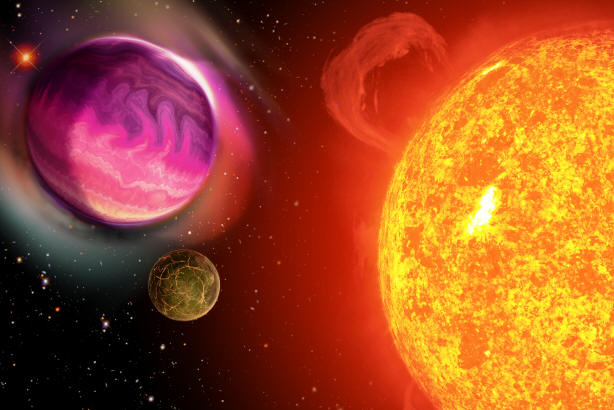Mysterious objects too hot to be
planets and too small to be stars
have been found.On March 7,
2009,
NASA launched
the
Kepler Space Telescope on
a three and a half year mission
designed to search for planets
revolving around other stars.
Astronomers have been investigating
the possibility that there are other
stellar families outside of the
Solar System for many years, but
Earth-based telescopes have been
able to detect only gas giants that
are Jupiter-sized or larger. Kepler
was built to find planets that are
similar in size to Earth.
In 1992, radio astronomers found
a pair of objects in orbit around
PSR B1257+12, a radio pulsar 980
light-years away, as astronomers
reckon distance. Aleksander
Wolszczan and Dale Frail used a
"radial velocity" technique to
measure shifts in the pulsar's radio
frequency, inferring the existence
of dense bodies "tugging" on the
star.
Other extrasolar bodies were
found by teams such as those at the
Lick Observatory, headed up by
Geoff Marcy. Marcy is
credited with discovering 70 new
planets using a combination of
astrometry, calculating stellar
positional shifts caused by a
planet's gravitational pull, and
radial velocity measurements. That
information is also used to
determine the planetary masses and
orbits.
Kepler is using the "transit
method" to find remote worlds. By
observing a star's brightness, the
telescope can see when a planet
passes in front of the stellar disc
because there will be a reduction in
the light. Theoretically, that
slight dimming can be used to deduce
the size of the object occluding the
star. With repeated observations,
the transit interval can allude to
the planet's orbital duration.
Currently, the
Extrasolar Planets Encyclopaedia
lists 417 planets outside of the
Solar System.
Recently, Kepler scientists
announced that they have found five
potentially new planets around
various stars. Each of them are
possessed of strange characteristics
(one has the apparent density of
Styrofoam), but the strangest of all
is that two of them are incredibly
hot—hotter than their parent stars.
According to mission team members
they have no idea what they could
be. They are too hot to be planets,
but too small to be stars.
One of the "mysterious" new
objects is KOI 74b, with a
temperature of 39,000 Celsius, while
its stellar host is only 9400
Celsius. This cannot be explained
with consensus theories: why would a
planet be hotter than a star? That
is, if it is a planet. However,
because of its relatively small
size—about as large as Jupiter—it is
far too small for fusion fires to be
burning there.
Another bizarre object, this time
about as large as Neptune, with a
temperature near 15,000 Celsius, is
in such close proximity to its star
that it completes one revolution in
just over five days. Are these new
types of celestial object, or are
they simply conforming to the
characteristics of plasma double
layers, and the
Electric Star theory?
Intense magnetic fields have been
detected in space. Those fields are
thought to be generated by electric
currents flowing through and around
galaxies along light-years long
"transmission lines" called
Birkeland current
filaments. Magnetic forces constrict
the filaments, twisting them around
each other and forming "z-pinch"
compression zones. The pinch effect
is far more powerful than gravity
when it comes to concentrating
matter. Stars are formed when
z-pinch effects crush plasma into
rotating spheres of electric charge.
This concept has been elucidated
many times in these pages.
In a previous Picture of the Day
article, the
Electric Star theory was
proposed as a way to deal with the
then "puzzling" discovery of yellow,
super-giant stars orbiting close to
one another in the Holmberg IX
galaxy. The conventional view of
luminosity versus spectral class was
shown to be overturned by the
theory's premise. The theory also
predicts that binary star systems at
every stage of evolution and
luminosity should exist.
The
Electric Star theory
states that stellar fissioning will
occur if a star is under great
stress because of excess current
flow from the galactic generator. A
blue-white star might explosively
split into two or more daughter
stars if the input current passes a
critical threshold. In so doing, the
surface area increases, resulting in
a decrease in current density. The
two (or more) new stars will
experience a reduction in luminosity
and appear to be "older" as
conventional theories of stellar
evolution discuss age. The electric
currents flowing between the new
stars might also be interpreted as
heat.
Perhaps what the Kepler mission
has done is help to confirm the
Electric Star theory by providing
data that supports stellar
fissioning.
Stephen Smith







